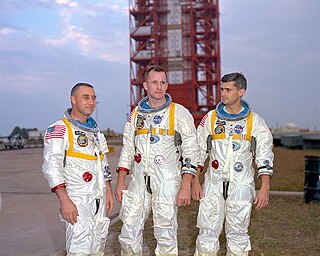 W
WApollo 1, initially designated AS-204, was the first crewed mission of the United States Apollo program, the undertaking to land the first man on the Moon. It was planned to launch on February 21, 1967, as the first low Earth orbital test of the Apollo command and service module. The mission never flew; a cabin fire during a launch rehearsal test at Cape Kennedy Air Force Station Launch Complex 34 on January 27 killed all three crew members—Command Pilot Gus Grissom, Senior Pilot Ed White, and Pilot Roger B. Chaffee—and destroyed the command module (CM). The name Apollo 1, chosen by the crew, was made official by NASA in their honor after the fire.
 W
WLaunch Complex 34 (LC-34) is a deactivated launch site on Cape Canaveral Space Force Station, Florida. LC-34 and its companion LC-37 to the north were used by NASA from 1961 through 1968 to launch Saturn I and IB rockets as part of the Apollo program. It was the site of the Apollo 1 fire, which claimed the lives of astronauts Gus Grissom, Ed White, and Roger Chaffee on January 27, 1967. The first crewed Apollo launch — Apollo 7 on October 11, 1968 — was the last time LC-34 was used.
 W
WRoger Bruce Chaffee was an American naval officer, aviator, and aeronautical engineer who was a NASA astronaut in the Apollo program.
 W
WDonn Fulton Eisele was a United States Air Force officer, test pilot, and later a NASA astronaut. He occupied the command module pilot seat during the flight of Apollo 7 in 1968. After retiring from both NASA and the Air Force, he became the Peace Corps country director for Thailand, before moving into private business.
 W
WFallen Astronaut is a 3.5-inch (8.9 cm) aluminum sculpture created by Paul Van Hoeydonck. It is a small stylized figure, meant to depict an astronaut in a spacesuit, intended to commemorate the astronauts and cosmonauts who have died in the advancement of space exploration. It was commissioned and placed on the Moon by the crew of Apollo 15 at Hadley Rille on August 1, 1971, next to a plaque listing the 14 men known who died. The statue lies horizontal on the ground among several footprints.
 W
WVirgil Ivan "Gus" Grissom was a United States Air Force (USAF) pilot and a member of the Mercury Seven selected by National Aeronautics and Space Administration's (NASA) as Project Mercury astronauts to be the first Americans in outer space. He was a Project Gemini and an Apollo program astronaut. As a member of the NASA Astronaut Corps, Grissom was the second American to fly in space. He was also the second American to fly in space twice, preceded only by Joe Walker with his sub-orbital X-15 flights.
The Apollo 1 Hills are three hills on Mars named to memorialize the crew of Apollo 1. The three hills were some of the first landmarks sighted following the January 7, 2004 landing of the Spirit rover on Mars.
 W
WEdward Higgins White II was an American aeronautical engineer, United States Air Force officer, test pilot, and NASA astronaut.